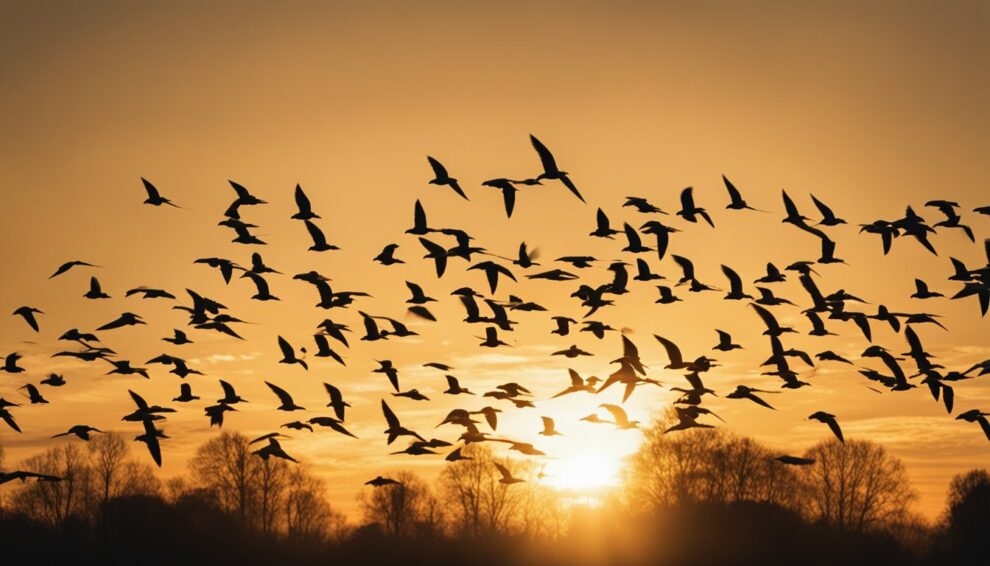Swifts are small, agile birds are known for their incredible flying abilities, and their ability to stay in the air for long periods of time without stopping.
In fact, some species of swifts can fly continuously for up to 10 months without ever touching down on the ground.

The mystery behind the continuous flight of swifts has puzzled scientists for years.
How do these birds manage to stay in the air for so long without getting tired or running out of energy?
What makes them such skilled flyers, and how do they navigate the skies with such ease?
These are just some of the questions that researchers are trying to answer as they study these remarkable birds.
Despite the many years of research, there is still much that we don’t know about swifts and their incredible flying abilities.
However, as scientists continue to study these birds, we are learning more and more about their unique characteristics and behaviors.
In this article, we will explore the mystery behind the continuous flight of swifts and discover what makes these birds such skilled and fascinating flyers.
The Life of Swifts
Swifts are majestic birds that spend most of their lives in the sky.
They are remarkable creatures that are known for their continuous flight, feeding, mating, and nesting habits.
These birds have fascinated ornithologists for centuries, and their unique lifestyle never ceases to amaze.
Majestic Flight and Feeding
Swifts are airborne for almost their entire lives. They feed on flying insects such as midges, mosquitoes, and flies.
They have a unique way of catching their prey while in flight, which is a sight to behold.
They can catch up to 1,000 insects per day, which is impressive considering their small size.
Mating and Nesting Habits
Swifts mate in the air, and they only land to build their nests. They are monogamous and mate for life.
They build their nests in crevices, holes, and cavities, using saliva to glue twigs and feathers together.
Once the chicks hatch, both parents take turns feeding them until they are ready to leave the nest.
Migration and Global Journeys
Swifts are migratory birds that travel thousands of miles each year.
They migrate to warmer regions during the winter months, and they return to their breeding grounds in the summer.
Some species of swifts, such as the common swifts, alpine swift, and black swift, travel incredible distances, crossing oceans and continents.
Swifts are fascinating creatures that have adapted to life in the sky.
They are capable of surviving without landing for months at a time, and they are excellent navigators, using the stars, wind, and magnetic cues to find their way.
They are also incredibly resilient, surviving heavy rain and storms while in flight.
In conclusion, swifts are amazing birds that have captured the imagination of scientists and nature lovers alike.
Their unique lifestyle and remarkable abilities make them a wonder of the natural world.
Anatomy and Adaptations

Wing Design and Flight Patterns
Swifts are remarkable birds with unique adaptations that allow them to fly continuously for months on end.
Their long, scythe-like wings and forked tails are perfectly designed for maximum speed and agility in the air.
With their wingspans of up to 40 cm, swifts are built for flight, and their streamlined bodies allow them to soar effortlessly through the sky.
Their wings are angled back, which helps them to generate lift and stay aloft, even in turbulent air.
Swifts are also capable of flying at incredibly high speeds, reaching up to 111 km/h (69 mph). This makes them one of the fastest birds in the world.
Resting, Roosting, and Sleep
Despite their ability to fly continuously for months, swifts do need to rest and roost occasionally.
They typically do this at dusk and dawn when they gather in large flocks and fly in a swirling, acrobatic display before settling down to roost for the night.
Swifts are unique in that they can sleep while flying.
They take short naps throughout the day, lasting only a few seconds each, during which they close one eye and let the other remain open to keep watch for predators.
This allows them to conserve their energy and continue flying for long periods.
Swifts roost in dark, sheltered places, such as caves, hollow trees, and even chimneys.
They use their sticky saliva to build their nests, which they attach to vertical surfaces.
These nests are a marvel of engineering, with each bird producing up to 1,000 saliva pellets per day to create a nest that is both strong and flexible.
In conclusion, swifts are fascinating birds with unique adaptations that allow them to fly continuously for months on end.
Their long, scythe-like wings and forked tails are perfectly designed for maximum speed and agility in the air, and they are capable of flying at incredibly high speeds.
Despite their ability to fly continuously, swifts do need to rest and roost occasionally, and they have developed unique adaptations to do so.
Conservation and Challenges

Habitat and Population Concerns
Swifts are fascinating birds that spend most of their lives in the sky, flying continuously for months on end.
However, their unique lifestyle also poses significant conservation challenges.
Swifts rely on specific habitats for breeding, nesting, and roosting, making them vulnerable to habitat loss and fragmentation.
In recent years, the global population of swifts has declined significantly due to habitat destruction, climate change, and human activities.
The destruction of forests, ponds, and mossy areas has led to the loss of breeding grounds and nesting sites, making it difficult for swifts to find suitable habitats.
To conserve swifts, it is essential to protect their habitats and breeding sites.
Governments, conservation organizations, and individuals can work together to create and maintain suitable habitats for swifts.
Creating artificial nesting boxes and roosting sites can also help to increase swift populations in urban areas.
Climate Impact and Human Interactions
Climate change poses a significant threat to swifts, affecting their range, breeding patterns, and food sources.
As temperatures rise, swifts may have to migrate further to find suitable habitats, putting additional stress on their populations.
Human interactions also pose a significant challenge to swift conservation.
Swifts are often seen as a nuisance in urban areas, leading to the destruction of their nests and breeding sites.
It is crucial to raise awareness about the importance of swifts and their role in the ecosystem to reduce human-wildlife conflicts.
In conclusion, swifts are unique and fascinating creatures that face significant conservation challenges.
By protecting their habitats, raising awareness, and reducing human-wildlife conflicts, we can ensure the survival of these remarkable birds for generations to come.
Frequently Asked Questions

How do swifts manage to sleep while flying?
Swifts are capable of sleeping while flying, but it is not yet clear how they do it.
Scientists believe that swifts can sleep with one half of their brain at a time. This is called unihemispheric slow-wave sleep.
During this state, one half of the brain is awake and alert, while the other half is in a deep sleep.
This allows swifts to rest and fly at the same time.
What adaptations allow a bird to fly for such extended periods?
Swifts have several adaptations that allow them to fly for extended periods.
One of the most important adaptations is their streamlined body shape, which reduces drag and allows them to fly more efficiently.
They also have large wings relative to their body size, which helps them generate lift and stay aloft.
Swifts also have a high metabolic rate, which allows them to convert food into energy quickly.
What is the record for the longest flight a bird has ever taken?
The record for the longest non-stop flight by a bird is held by a common swift.
In 2013, a common swift was tracked flying non-stop for 10 months from Europe to sub-Saharan Africa and back.
During this time, the bird covered a distance of over 14,000 miles.
Can all birds fly continuously or is it unique to certain species?
Not all birds can fly continuously. Some birds, like swifts and swallows, are capable of flying for extended periods without landing.
Other birds, like eagles and hawks, are not capable of sustained flight and must land frequently to rest and hunt.
How do swifts eat and drink during their long flights?
Swifts are capable of eating and drinking while flying.
They catch insects in their beaks while flying and can drink water by skimming the surface of lakes and rivers.
They can also drink rainwater while flying through rainstorms.
What challenges do swifts face while flying for years without landing?
Swifts face several challenges while flying for years without landing. One of the biggest challenges is finding enough food to sustain themselves.
Swifts must catch insects while flying, which requires a high level of skill and energy expenditure.
Another challenge is avoiding predators while flying.
Swifts are vulnerable to predators like hawks and falcons, which can attack them while they are in flight.
Finally, swifts must navigate over long distances without getting lost, which requires a high level of spatial awareness and memory.









